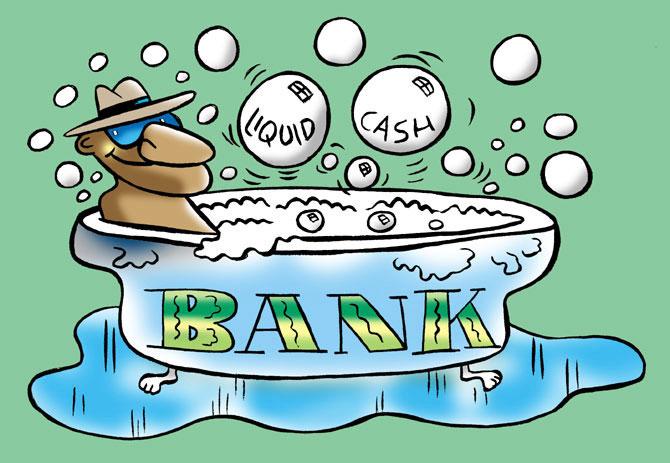 | « Back to article | Print this article |
The last such liquidity scene was witnessed just after demonetisation in end of 2016 and early 2017 when banks were parking their deposit-linked money with the central bank.
The central bank is also trying to influence the yield curve, instead of leaving it to the market forces.
The reason could be to correct the spread between the shorter-term bonds and the steep longer term yields through OMOs, but the market expects RBI to prepare grounds for the government to borrow extra at a lower rate.
This is because the rate cut support coming from RBI would be very limited going forward, after it paused in December.
Anup Roy reports.

The surplus liquidity in the banking system crossed Rs 4 trillion a recent data showed, as the government redeemed Rs 61,000 crore of its bonds issued in 2003, and possibly because of some expenditure done.
The government will be borrowed 70-days money worth Rs 30,000 crore through the Cash Management Bill on Monday, and the Reserve Bank of India did a 63-day reverse repo auction of Rs 25,000 crore on Friday to absorb part of the Rs 4.15 trillion of excess liquidity.
Otherwise, the system liquidity was hovering at around Rs 2-Rs 2.5 trillion in December, and at Rs 3 trillion on January 1.
The last such liquidity scene was witnessed just after demonetisation in end of 2016 and early 2017 when banks were parking their deposit-linked money with the central bank.
However, unlike demonetisation era, this time the central bank is much more prepared to absorb the excess liquidity, should there be a need.
During demonetisation, the central bank had only about Rs 7 trillion of bond holding.
In the recent past, the central bank has stepped up its bond purchases to jack up its bond holdings to more than Rs 9 trillion.
The central bank has to give bonds in return for money it takes from banks.
But bond dealers don’t see the high liquidity surplus disturbing the system as such, except for some minor hiccups.
The monetarist school of economists believe that surplus liquidity leads to inflation, but it is not always so.
There are other factors that can counteract the liquidity impact on inflation.
“In the current case, it looks unlikely that inflation will pick up due to the surplus liquidity.
"Demand in the economy is still quite weak.
"The surplus liquidity will keep the overnight rates at or slightly below the repo rates,” said Badrish Kullhalli.
So what possibly might happen if there is abundant liquidity in the system for a long time?
“Abundant liquidity has been key instrument for absorbing a portion of systematic risk in the last one year.
"However, in the absence of any pickup in activity in the credit market, this will continue to dampen money multiplier,” said Soumyajit Niyogi, associate director at India Ratings and Research.
“The concern is in spite of soft demand for credit, system is incrementally becoming more dependent on central bank in the G-Sec market,” Niyogi said.
The central bank is also trying to influence the yield curve, instead of leaving it to the market forces.
The reason could be to correct the spread between the shorter-term bonds and the steep longer term yields through open market operations (OMO), but the market expects the central bank to prepare grounds for the government to borrow extra at a lower rate.
This is because the rate cut support coming from the central bank would be very limited going forward, after it paused in December.
“RBI is unlikely to take any steps to mop up the surplus liquidity, in the near term.
"In addition to the special OMOs, RBI probably expects the surplus liquidity to help in keeping short end yields low.
"The large surplus liquidity will probably prevent any outright OMO purchases by RBI and may lead to more Special OMOs, if RBI wants to contain any yield spike in long end yields,” Kullhalli said.
At the end, though, the Rs 2 trillion surplus, or Rs 4 trillion surplus, doesn’t make much difference for the system.
“It is a temporary aberration, likely caused by redemption and step up in government expenditure coming together.
"In any case, it won’t impact the yields much except for overnight yields,” said Indranil Pan, chief economist of IDFC First Bank.
The 10-year bond yield closed at 6.51 per cent on Friday, almost flat from its previous close.